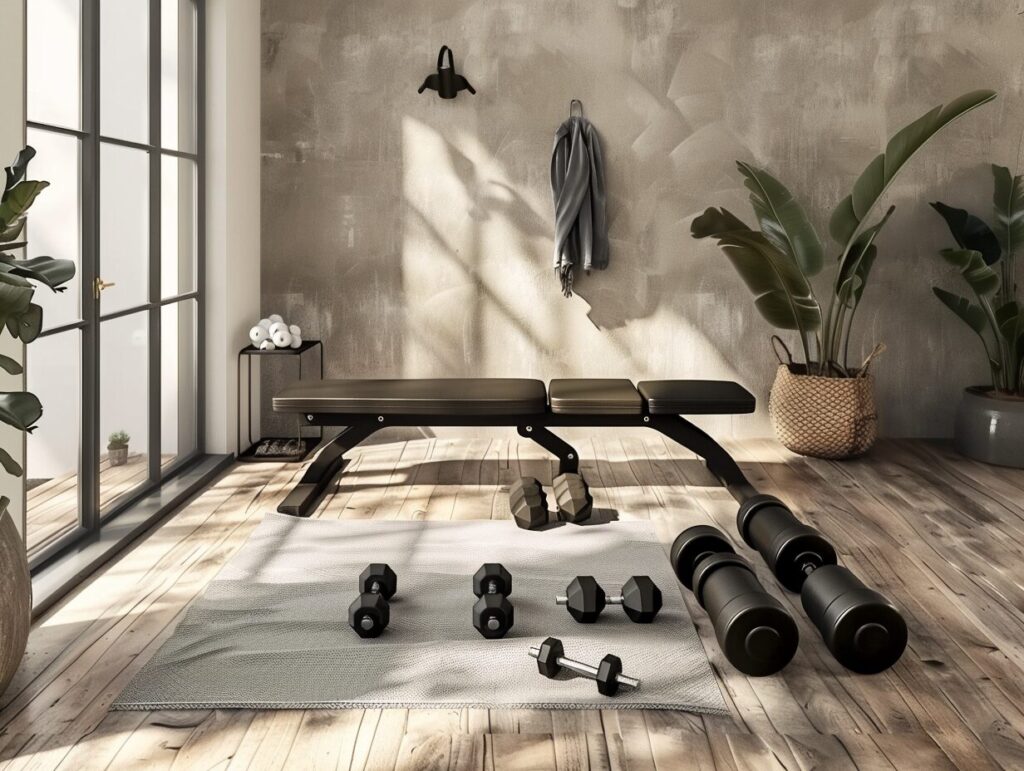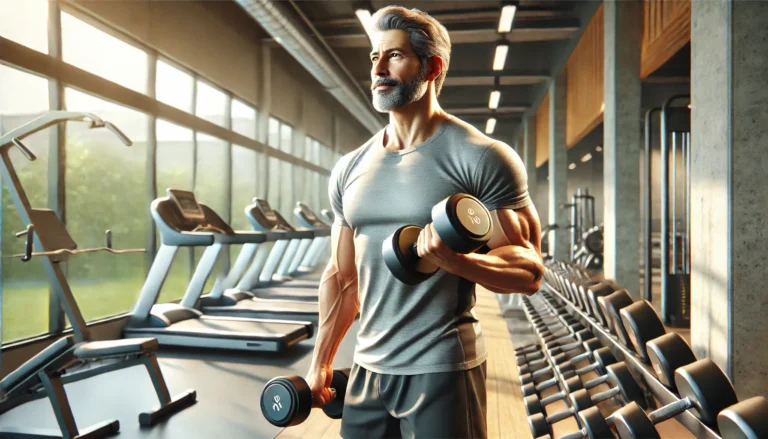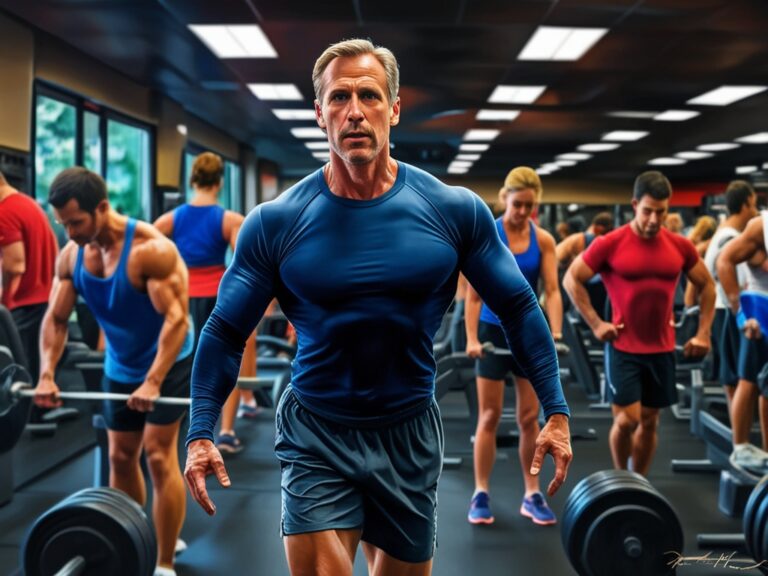Did you know that muscle mass starts to decline by 3-5% every decade after we hit 30. I’m pretty excited to chat with you about something that’s been a game-changer for me: creating a killer home gym that keeps us active, healthy, and feeling like we’re still in our prime!
Let’s face it, staying active after 40 isn’t just about looking good in our favorite jeans. It’s about maintaining our independence, keeping up with the kids, and maybe even showing those younger folks a thing or two at the company softball game. But here’s the kicker – life gets busy, and sometimes hitting the gym feels like another chore on our never-ending to-do list. That’s where a home gym comes in clutch.
In this article, we’re going to dive into all the essential equipment you need to create an awesome home gym that’ll keep you active and thriving well into your golden years. We’ll cover everything from cardio machines that’ll get your heart pumping to strength training gear that’ll help you maintain that all-important muscle mass. Plus, I’ll share some tips on flexibility and balance equipment that’ll keep you feeling nimble and steady on your feet.
So, grab a cup of coffee (or a protein shake if you’re feeling extra fitness-y), and let’s get into it. By the time we’re done, you’ll be itching to clear out that spare room and turn it into your personal fitness paradise. Ready to take control of your health and show Father Time who’s boss? Let’s do this!
Understanding the Importance of Exercise After 40
Alright, let’s get real for a minute. When I hit 40, I noticed some changes that, quite frankly, I wasn’t thrilled about. Suddenly, those stairs at work seemed a bit more daunting, and don’t even get me started on how my favorite jeans started to fit! But here’s the thing – I quickly learned that these changes weren’t just in my head.
You see, our bodies start to play this sneaky little game as we age. Remember that stat about muscle mass declining? Well, that’s just the tip of the iceberg. Our metabolism slows down, bone density can decrease, and even our balance might not be what it used to be. It’s like our bodies are trying to pull a fast one on us!
But here’s where it gets exciting – regular exercise is like our secret weapon against these changes. It’s not about turning back the clock, it’s about making the most of where we are right now. And let me tell you, the benefits are pretty darn impressive:
- Muscle Maintenance: Strength training helps us hang onto that precious muscle mass. Trust me, you’ll appreciate this when you’re effortlessly lifting those heavy grocery bags or playing with the grandkids.
- Bone Boosting: Weight-bearing exercises can help maintain bone density. I like to think of it as giving my skeleton a little pep talk every time I work out.
- Heart Health: Cardio exercises keep our tickers in top shape. Plus, it’s a great excuse to dance around your living room to your favorite 80s hits (no judgment here!).
- Flexibility and Balance: Stretching and balance exercises can help prevent those embarrassing “I’ve fallen and I can’t get up” moments. Because let’s face it, we’re not as bouncy as we used to be!
- Mental Clarity: Exercise isn’t just good for the body; it’s a brain booster too. I swear, after a good workout, I feel like I could tackle the New York Times crossword puzzle (okay, maybe just the Monday one).
Now, I know what some of you might be thinking. “But I’ve never been an athlete!” or “Isn’t it too late to start?” Let me stop you right there. I was the kid always picked last in gym class, and I didn’t start taking fitness seriously until my late 30s. And you know what? It’s never too late!
In fact, I’d argue that exercising after 40 is even more crucial than when we were younger. We’re not trying to win Olympic medals here. We’re investing in our quality of life, our independence, and our ability to keep up with this crazy, wonderful world.
So, let’s bust those misconceptions wide open:
- “I’m too old to start” – Nope! Your body will thank you for starting, no matter your age.
- “Exercise is too risky at my age” – With the right guidance and equipment, exercise can actually reduce your risk of injury.
- “I don’t have time” – That’s where the beauty of a home gym comes in. Even 15 minutes a day can make a difference!
Remember, we’re not over the hill – we’re just getting warmed up for the next climb! In the next section, we’ll dive into the cardio equipment that’ll help keep your heart happy and your energy levels high. Get ready to give your old ticker some love!
Essential Cardiovascular Equipment for Home Workouts
Alright, fellow fitness enthusiasts, let’s talk about getting our hearts pumping! When I first decided to create my home gym, I was overwhelmed by all the cardio equipment options. It felt like I needed a PhD in gym science just to figure out what would work best for me. But fear not! I’ve done the legwork (pun intended), and I’m here to break it down for you.
Treadmills: The Classic Calorie Crusher
Let’s start with the treadmill, the granddaddy of cardio equipment. I’ll admit, I was skeptical at first. “Isn’t that just a glorified clothes rack?” I thought. Boy, was I wrong!
Pros:
- Great for walking or running, rain or shine
- Adjustable incline to simulate hill climbs.
- Many models have built-in workout programs (perfect for those days when your brain needs a break)
Cons:
- Can be tough on the joints, especially if you’re a runner
- Takes up a fair bit of space
- Can be noisy (your downstairs neighbors might not appreciate your 5 AM marathon training)
Space-Saving Tip: Look for foldable models.
Stationary Bikes: Spin Your Way to Fitness
Next up, we have stationary bikes. These babies come in a few different flavors:
Upright Bikes:
- Similar to a regular bicycle
- Great for a low-impact workout
- Compact and usually more affordable
Recumbent Bikes:
- Have a comfy seat with back support
- Ideal if you have balance issues or lower back pain
- Perfect for multitasking. You can easily read a book or even take a work call while pedaling
Spin Bikes:
- Closer to a real road bike experience
- Intense workouts for serious calorie burning
- Fair warning: The first time I tried a spin class, I couldn’t sit comfortably for a week!
Elliptical Machines: The Joint-Friendly Jog
Ah, the elliptical. This is the machine that made me feel like I was gliding on air.
Benefits:
- Low-impact (great for those of us with creaky knees)
- Works both upper and lower body
- Smooth motion that feels less jarring than a treadmill
The only downside? You might feel a bit like you’re cross-country skiing in your living room. But hey, embrace it! Throw on some snow sound effects, and you’ve got yourself a winter wonderland workout.
Rowing Machines: The Full-Body Blaster
Last but certainly not least, we have the rowing machine. This bad boy snuck up on me – I didn’t expect to love it as much as I do!
Why it’s awesome:
- Works 86% of your muscles (that’s a lot of bang for your buck!)
- Low-impact, so it’s easy on the joints
- Great for improving posture (goodbye, computer hunch!)
Just a heads up: There’s definitely a learning curve with proper rowing form. The first time I used one, I looked like a flailing octopus. But once you get it down, it’s smooth sailing (or should I say, rowing?).
Now, I know what you’re thinking. “Do I need ALL of these machines?” Absolutely not! The key is to choose what works best for you, your space, and your fitness goals. Maybe you’re a die-hard runner who needs a treadmill. Or perhaps you’re looking for a low-impact option and the elliptical is calling your name.
Remember, the best cardio equipment is the one you’ll actually use. For me, I ended up with a compact elliptical and a rowing machine. It’s the perfect combo for my creaky knees and my desire for a full-body workout.
In the next section, we’ll dive into strength training equipment. Trust me, you’ll want to stick around for this – building muscle is like giving your metabolism a permanent boost. Who doesn’t want that? So, grab a water break, stretch those muscles, and let’s keep this fitness party going!
Strength Training Equipment for Maintaining Muscle Mass
Alright, muscle mavens, it’s time to talk about pumping some iron! Or in my case, fumbling with dumbbells while trying not to drop them on my toes.
Now, before we dive in, let’s address the elephant in the room. No, strength training won’t turn you into the Incredible Hulk overnight (unless that’s your goal, in which case, more power to you!). What it will do is help you maintain muscle mass, boost your metabolism, and make everyday tasks a whole lot easier.
Let’s break down some essential strength training equipment that won’t break the bank or turn your home into a professional bodybuilding gym:
Adjustable Dumbbells: The Shape-Shifters of Strength Training
Oh, adjustable dumbbells, how do I love thee? Let me count the ways:
- Space-saving: These bad boys replace an entire rack of dumbbells. My spare room thanked me!
- Versatile: You can adjust the weight for different exercises or as you get stronger.
- Cost-effective: Cheaper than buying multiple sets of dumbbells.
Personal anecdote time: When I first got my adjustable dumbbells, I felt like a kid with a new toy. I may or may not have spent an embarrassing amount of time just changing the weights back and forth. Hey, it counts as a workout, right?
Resistance Bands: The Unsung Heroes of Home Workouts
Don’t let their innocent appearance fool you. These colorful rubber bands pack a serious punch:
- Portable: You can literally stuff them in your pocket.
- Versatile: Use them for strength training, stretching, or even physical therapy exercises.
- Joint-friendly: Great for low-impact strength training.
Pro tip: Make sure you have a good grip!
Kettlebells: The Cannonballs of Fitness
Kettlebells might look like medieval weapons, but they’re actually fantastic for building functional strength:
- Full-body workouts: Many kettlebell exercises engage multiple muscle groups at once.
- Improve balance and coordination: Swinging a kettlebell requires more stability than traditional weights.
- Great for high-intensity workouts: Hello, metabolism boost!

Word of caution: Start light and focus on form. My first kettlebell swing looked more like a wild, flailing dance move than an exercise. Thank goodness for YouTube tutorials!
Weight Bench: The Versatility Virtuoso
A good weight bench is like the Swiss Army knife of strength training:
- Expands your exercise options: Use it for bench presses, step-ups, tricep dips, and more.
- Adjustable incline: Target different muscle groups by changing the angle.
- Compact: Many models fold up for easy storage.
Here are some tips for strength training success:
- Start light: There’s no shame in beginning with small weights or even just your body weight. Form is more important than the amount you’re lifting.
- Focus on compound exercises: Moves like squats, deadlifts, and chest presses give you more bang for your buck by working multiple muscle groups at once.
- Don’t forget rest days: Muscles need time to recover and grow stronger. I learned this the hard way after trying to do bicep curls every day for a week. Hello, T-rex arms!
- Proper form is key: If possible, work with a trainer initially to learn correct form. Your joints will thank you later.
- Progress gradually: Increase weight or resistance slowly over time. Remember, we’re in this for the long haul, not just for beach season!
Remember, strength training isn’t just about building bulging biceps (though that’s a nice bonus). It’s about maintaining our independence, improving our bone density, and yes, maybe impressing the grandkids with our ability to open tough jars.
In our next section, we’ll explore flexibility and balance equipment. Because let’s face it, being strong is great, but not if you pull a muscle trying to tie your shoelaces!
Flexibility and Balance Equipment for Injury Prevention
Alright, limber legends, it’s time to talk about the unsung heroes of fitness: flexibility and balance. When I first started my fitness journey, I was all about the cardio and strength training. Stretching? That was just something I did while reaching for the TV remote. Balance? I figured if I could walk without tripping over my own feet, I was golden.
Boy, was I in for a wake-up call! One day, while attempting to put on my socks (a task that used to be so simple), I nearly pulled a muscle and ended up looking like a pretzel gone wrong. That’s when I realized: flexibility and balance aren’t just fancy extras – they’re essential, especially as we gracefully age past 40.
So, let’s dive into some equipment that’ll help keep you bendy, balanced, and less likely to pull something while tying your shoes:
Yoga Mats: Your Personal Island of Zen
First up, the humble yoga mat. Don’t let its simplicity fool you – this is the Swiss Army knife of flexibility equipment:
- Provides cushioning for joints during floor exercises
- Offers a non-slip surface for balance work
- Doubles as a great place for post-workout naps
Stability Balls: The Bouncy Path to Better Balance
Ah, stability balls. Or as I like to call them, “The Spheres of Occasional Embarrassment”:
- Great for core strengthening exercises
- Improves balance and coordination
- Can double as an office chair. Seriously!
Foam Rollers: The “Hurts So Good” Cylinder of Joy
Foam rollers are like that friend who always tells you the truth, even when it hurts:
- Excellent for self-myofascial release (fancy term for “ouch, that feels good”)
- Helps improve flexibility and reduce muscle soreness
- Can be used to improve balance in certain exercises
Balance Boards: The Wobble Wonders
Balance boards are like surfboards for your living room, minus the water and cool factor:
- Improves proprioception (your body’s ability to sense movement and position)
- Strengthens ankles and helps prevent falls
- Makes you feel like a circus performer (in a good way)
Now, you might be thinking, “Do I really need all this stuff?” The answer is: not necessarily. But incorporating even one or two of these items into your routine can make a world of difference. Here’s why flexibility and balance are so crucial, especially after 40:
- Injury Prevention: Flexible muscles and good balance mean you’re less likely to pull something during everyday activities or workouts.
- Improved Posture: Stretching can help counteract the effects of sitting hunched over a computer all day. (Goodbye, tech neck!)
- Better Range of Motion: This means easier movement in daily life, from reaching for that top shelf to bending down to tie your shoes.
- Stress Relief: Stretching and balance exercises can be incredibly relaxing. It’s like a mini-vacation for your muscles!
- Fall Prevention: As we age, good balance becomes crucial. Nobody wants to be that person who trips over thin air.
Here are some tips to get you started:
- Start Slow: Rome wasn’t built in a day, and you won’t turn into a yoga master overnight. Be patient with yourself.
- Consistency is Key: A little bit every day is better than a marathon session once a month.
- Listen to Your Body: The goal is to feel a gentle stretch, not pain. If it hurts, ease off.
- Make It Fun: Put on some music, or stretch while watching TV. I personally love doing balance exercises during commercial breaks – it makes ads much more bearable!
- Don’t Forget to Breathe: It sounds obvious, but you’d be surprised how often we hold our breath during stretching. Breathe through the stretch for better results.
Remember, flexibility and balance work isn’t about touching your toes or standing on one foot for hours (though if you can do that, more power to you!). It’s about moving better, feeling better, and setting ourselves up for a future where we can still chase after the grandkids without pulling a hamstring.
In our next section, we’ll explore equipment for High-Intensity Interval Training (HIIT). Because sometimes, you just need to pretend you’re outrunning a dinosaur to get that heart rate up! So, take a deep breath, give those muscles a good stretch, and let’s keep this flexibility train rolling!
High-Intensity Interval Training (HIIT) Equipment
Alright, it’s time to talk about HIIT! When I first heard about High-Intensity Interval Training, I thought it was some sort of secret workout regimen for superheroes. Turns out, it’s just a fancy way of saying “work really hard for a short time, then rest, repeat.” And let me tell you, it’s been a game-changer for me.
Here’s some equipment that’ll help you get your HIIT on without turning your home into a CrossFit box:
Jump Ropes: Not Just for Schoolyards Anymore
- Incredible cardio workout in a tiny package
- Improves coordination (and patience – trust me on this one)
- Portable and affordable
Pro tip: Start slow. My first attempt at jump rope looked like a failed audition for Riverdance. Now I can almost go a full minute without tripping!
Plyo Boxes: The Step-Ups of Champions
- Great for box jumps, step-ups, and elevated pushups
- Adjustable heights for different exercises and fitness levels
- Doubles as a place to sit when you’re questioning your life choices mid-workout
Safety note: Start with step-ups before attempting box jumps. I may or may not have an embarrassing story involving a too-high box and a bruised ego.
Medicine Balls: The Cannonballs of Fitness
- Versatile for both strength and cardio exercises
- Great for rotational movements
- Satisfying to slam (just watch out for downstairs neighbors)
Funny story: I once dropped a medicine ball on my foot. The good news? I discovered I could still hop on one foot pretty well. Silver linings, folks!
Suspension Trainers: Defying Gravity (Sort Of)
- Uses body weight for resistance
- Highly versatile for full-body workouts
- Easily adjustable for different fitness levels
Word of caution: Make sure it’s securely attached.
Creating a Well-Rounded Home Gym on a Budget
Now, I know what you’re thinking. “This all sounds great, but I can’t afford to turn my spare room into a boutique fitness studio!” Fear not, my frugal friends. Here’s how to create a killer home gym without breaking the bank:
- Prioritize Based on Your Goals
- Focus on versatile equipment that serves multiple purposes
- Start with the basics and add as you go
- Look for Multi-Functional Equipment
- Adjustable dumbbells instead of multiple sets
- A stability ball that can double as a weight bench
- DIY Some Equipment
- Filled water bottles can be weights
- A sturdy chair can be a step platform
- Incorporate Bodyweight Exercises
- Pushups, squats, and lunges are free and effective
- Use stairs for cardio if you don’t have a treadmill
Remember, the best home gym is the one you’ll actually use. My first “gym” was a yoga mat, a set of medium weight dumbells, and an (un)healthy addiction to fitness YouTube videos. But you know what? It worked!
Safety Considerations for Home Workouts After 40
Alright, let’s get serious for a moment. As much as I love cracking jokes about my fitness foibles, safety is no laughing matter, especially for us 40-plusers.
- Proper Form is Everything
- Take the time to learn correct techniques
- Consider a session or two with a personal trainer to get started
- Warm-Up and Cool-Down are Non-Negotiable
- Dynamic stretches before workouts
- Static stretches and gentle movements after
- Listen to Your Body
- Pain is different from discomfort – know the difference
- Rest days are as important as workout days
- Start Slow and Progress Gradually
- Consistency trumps intensity every time
- Gradually increase duration and intensity of workouts
- Consider Your Environment
- Ensure you have enough space for movements
- Use stable surfaces for balance exercises
Remember, we’re not training for the Olympics here (unless you are, in which case, go you!). The goal is to feel better, move better, and maybe impress the grandkids with our newfound vitality.
Conclusion: Your Home Gym Journey Begins!
Well, we’ve covered a lot of ground – from cardio machines to yoga mats, from strength training to the importance of not dropping medicine balls on your feet. But here’s the most important thing to remember: the best home gym is the one that works for you.
Start small, be consistent, and don’t be afraid to laugh at yourself along the way. Read our post, Strength Training for Longevity: Why It’s Crucial After 40 and Middle-Age Unleashed: My Secrets to Strength Training Success, for insights on strength training for us men over 40.
Remember, creating a home gym and starting a fitness journey after 40 isn’t about turning back the clock. It’s about making the most of where we are right now and setting ourselves up for a future where we can still bust a move at family weddings without pulling a muscle.
So, clear out that spare room, dust off those workout clothes, and get ready to embark on your home gym adventure. Your future self will thank you – and hey, you might even have some fun along the way!
Now, I’d love to hear from you! What’s your favorite piece of home gym equipment? Any hilarious workout bloopers you’d care to share? Drop a comment below and let’s keep this fitness conversation going. After all, misery loves company – and so does success!
Until next time, keep moving, keep laughing, and remember: age is just a number, but a good workout is timeless!








